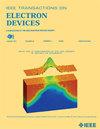On the Interaction Between Hot Carrier Degradation (HCD) and Electrical-Induced Breakdown (EiB) in Advanced FinFET Nodes
IF 2.9
2区 工程技术
Q2 ENGINEERING, ELECTRICAL & ELECTRONIC
引用次数: 0
Abstract
The interaction between hot carrier degradation (HCD) and electrical-induced breakdown (EiB) in FinFETs at advanced technology nodes is investigated for the first time. Unlike previous findings in planar FETs, HCD significantly impacts EiB in FinFETs, with opposite effects on n- and p-type. Our analysis reveals that the competitive mechanism between defect-induced leakage increase and defect-induced electric field reduction is the primary cause of these differences. For nFinFETs, HCD-induced defects lead to significant leakage current and substantial Joule heating, both of which accelerate the breakdown of interconnect M0 metal. Conversely, for pFinFETs, the leakage current increase is negligible, while fixed charges generated in the high-k (HK) layer reduce the internal electric field within the dielectric, thereby slowing down EiB. The study also traces the physical origins of defects caused by HCD, identifying hydroxyl-E高级FinFET节点中热载流子降解(HCD)与电致击穿(EiB)的相互作用
本文首次研究了finfet在先进技术节点上的热载流子降解(HCD)和电致击穿(EiB)之间的相互作用。与先前在平面fet中的发现不同,HCD显著影响finfet中的EiB,对n型和p型的影响相反。我们的分析表明,缺陷引起的泄漏增加和缺陷引起的电场减少之间的竞争机制是造成这些差异的主要原因。对于nfinfet, hcd诱导的缺陷会导致显著的泄漏电流和大量的焦耳加热,这两者都会加速互连M0金属的击穿。相反,对于pfinfet,泄漏电流的增加可以忽略不计,而在高k (HK)层中产生的固定电荷减少了介电介质内的内部电场,从而减缓了EiB。该研究还追溯了由HCD引起的缺陷的物理起源,确定了IL层中的羟基- e $^{\prime}$ (H-E $^{\prime}$)中心和HK层中的氧空位(Vo)是导致n-和p- finfet不同泄漏行为的关键因素。为了解决nfinfet中HCD在EiB上带来的可靠性挑战,提出了一种考虑HCD和EiB之间相互作用的新型M0金属设计方法,为提高先进技术节点的互连可靠性提供了途径。
本文章由计算机程序翻译,如有差异,请以英文原文为准。
求助全文
约1分钟内获得全文
求助全文
来源期刊

IEEE Transactions on Electron Devices
工程技术-工程:电子与电气
CiteScore
5.80
自引率
16.10%
发文量
937
审稿时长
3.8 months
期刊介绍:
IEEE Transactions on Electron Devices publishes original and significant contributions relating to the theory, modeling, design, performance and reliability of electron and ion integrated circuit devices and interconnects, involving insulators, metals, organic materials, micro-plasmas, semiconductors, quantum-effect structures, vacuum devices, and emerging materials with applications in bioelectronics, biomedical electronics, computation, communications, displays, microelectromechanics, imaging, micro-actuators, nanoelectronics, optoelectronics, photovoltaics, power ICs and micro-sensors. Tutorial and review papers on these subjects are also published and occasional special issues appear to present a collection of papers which treat particular areas in more depth and breadth.
 求助内容:
求助内容: 应助结果提醒方式:
应助结果提醒方式:


